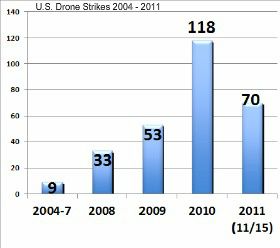 Since taking office in 2009, President Obama has waged an increasing clandestine war using unmanned drones controlled by civilians members of the CIA. In a recent article Washington Post‘s Greg Miller exposes some troubling aspects of the program which has little oversight or control:
Since taking office in 2009, President Obama has waged an increasing clandestine war using unmanned drones controlled by civilians members of the CIA. In a recent article Washington Post‘s Greg Miller exposes some troubling aspects of the program which has little oversight or control:
In the space of three years, the administration has built an extensive apparatus for using drones to carry out targeted killings of suspected terrorists and stealth surveillance of other adversaries. The apparatus involves dozens of secret facilities, including two operational hubs on the East Coast, virtual Air Force cockpits in the Southwest and clandestine bases in at least six countries on two continents. [..]
The rapid expansion of the drone program has blurred long-standing boundaries between the CIA and the military. Lethal operations are increasingly assembled a la carte, piecing together personnel and equipment in ways that allow the White House to toggle between separate legal authorities that govern the use of lethal force.
In Yemen, for instance, the CIA and the military’s Joint Special Operations Command pursue the same adversary with nearly identical aircraft. But they alternate taking the lead on strikes to exploit their separate authorities, and they maintain separate kill lists that overlap but don’t match. CIA and military strikes this fall killed three U.S. citizens, two of whom were suspected al-Qaeda operatives. [..]
Obama himself was “oddly passive in this world,” the former official said, tending to defer on drone policy to senior aides whose instincts often dovetailed with the institutional agendas of the CIA and JSOC.
Joshua Foust in The Atlantic observes that there are consequences for the successes claimed by the Obama Administration:
In the countries where the drone system is most active — Pakistan and Yemen — relations with local governments and communities are awful, and perceptions of the United States could barely be any worse. There is agreement seemingly only on the need for long distance killing, and even then — especially in Pakistan — there is a great deal of contention.
In fact, one could argue that the severe degradation of relations with Pakistan, which are driven to a large degree by popular anger over drone strikes (as well as a parallel perception among some Pakistani elites that the U.S. disregards Pakistani sovereignty at will), is driving the current U.S. push to ship supplies and, eventually, the withdrawal from Afghanistan, through Uzbekistan.
Besides the political consequences, Foust notes the reorientation of the intelligence community to this killing program may hinder its ability of collecting and analyzing the data needed and a heavy reliance on information from sketchy local partners that can, and has, resulted in unnecessary fatalities. His opinion of Obama’s expansion of the drone war is scathing:
This sloppiness with life and death decisions is a substantial moral failing, and should be a huge scandal for President Obama. But, he has decided to both distance himself from it while also taking credit for its successes, even as it focuses on ever less important and marginal figures within the terrorist milieu. [..]
It is an absolute scandal. We owe ourselves better questions and more accountability of the drones we use to wantonly kill people around the planet.
Senior reporter for Wired.com’s Danger Room, Spencer Ackerman, discussed the sharp increase in drone attacks to do the military’s job since Obama took office.

2 comments
Author
Author
nothing will
Contractors’ role grows in drone missions, worrying some in the military
What lambert said: